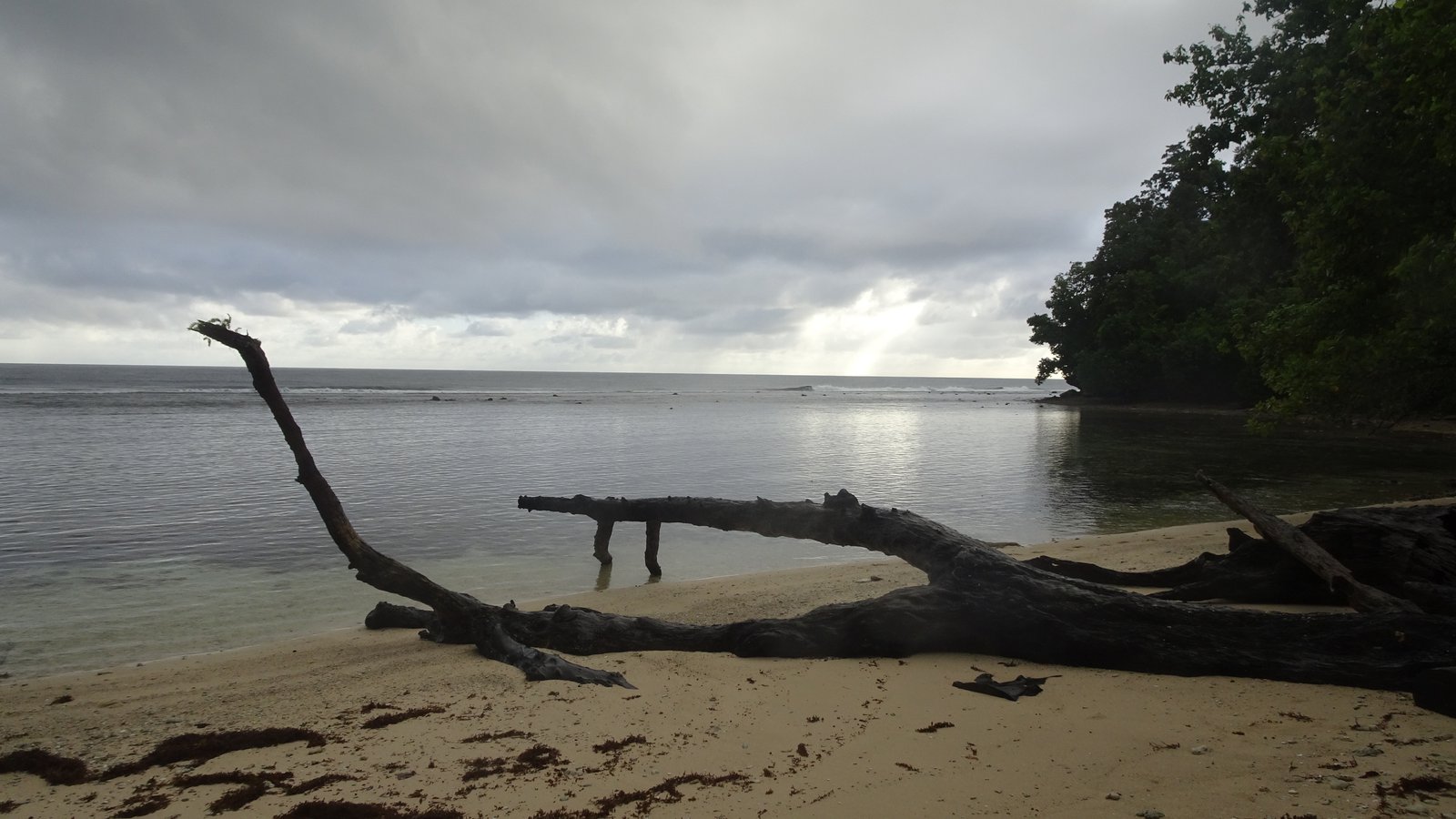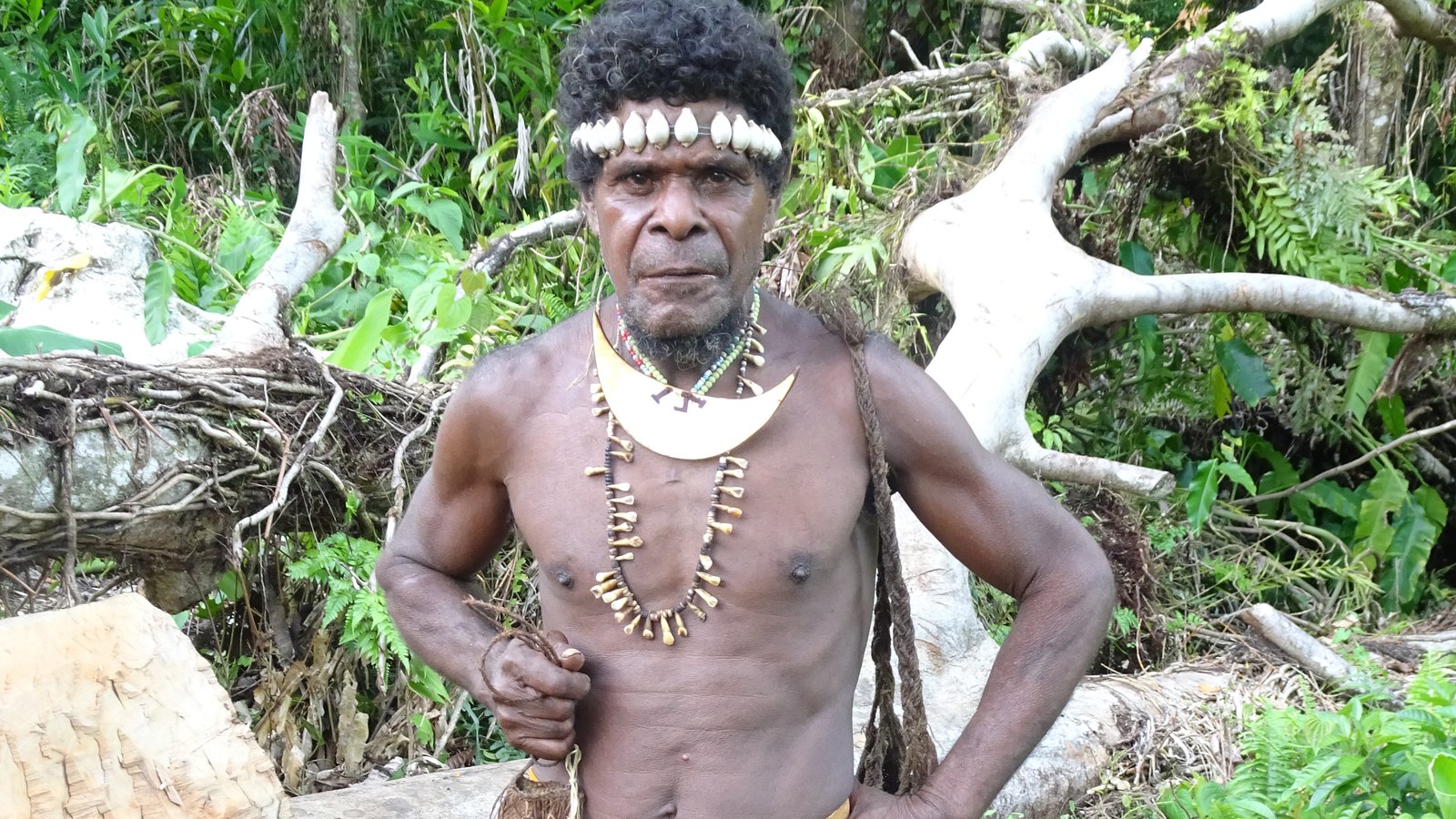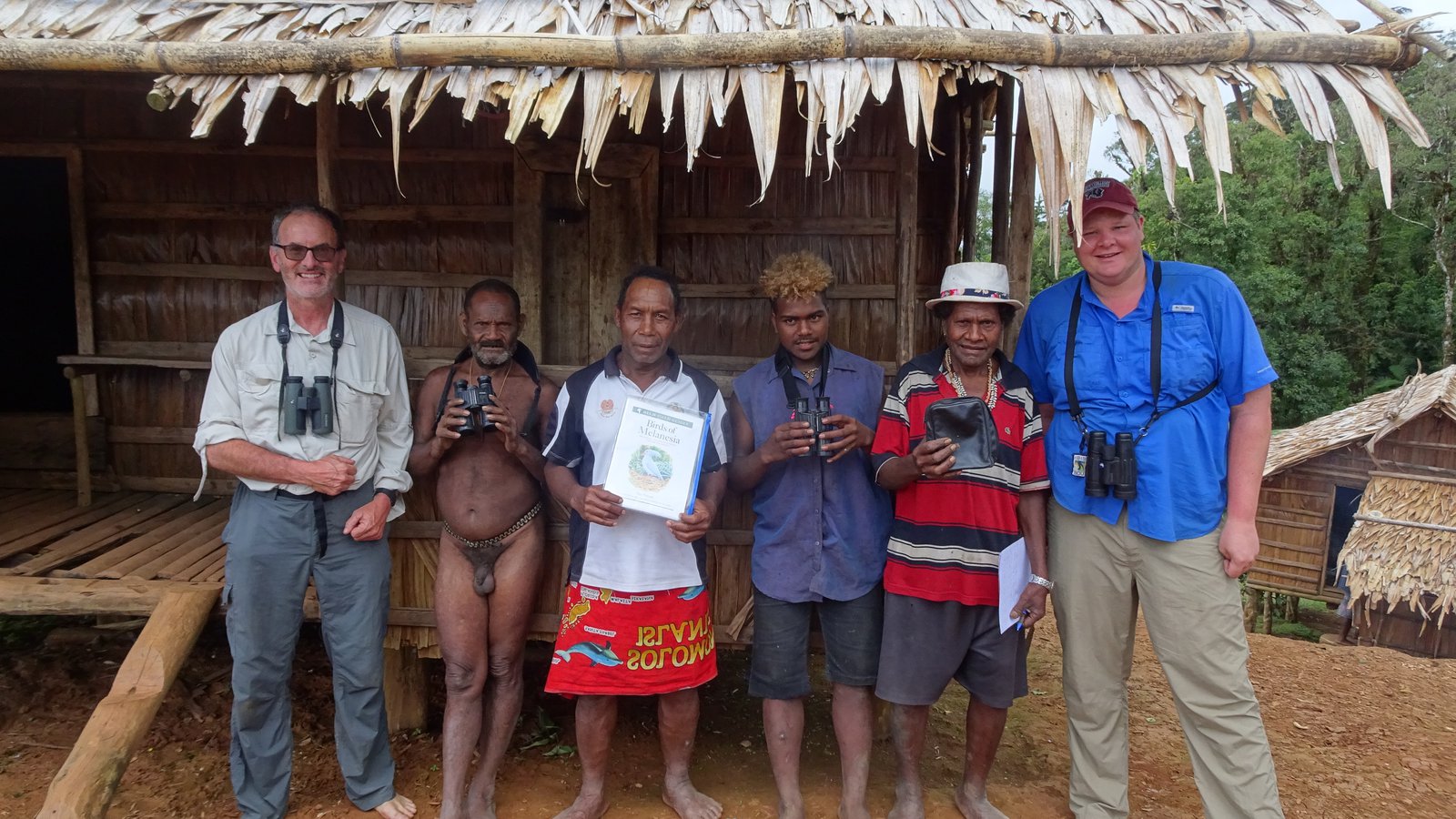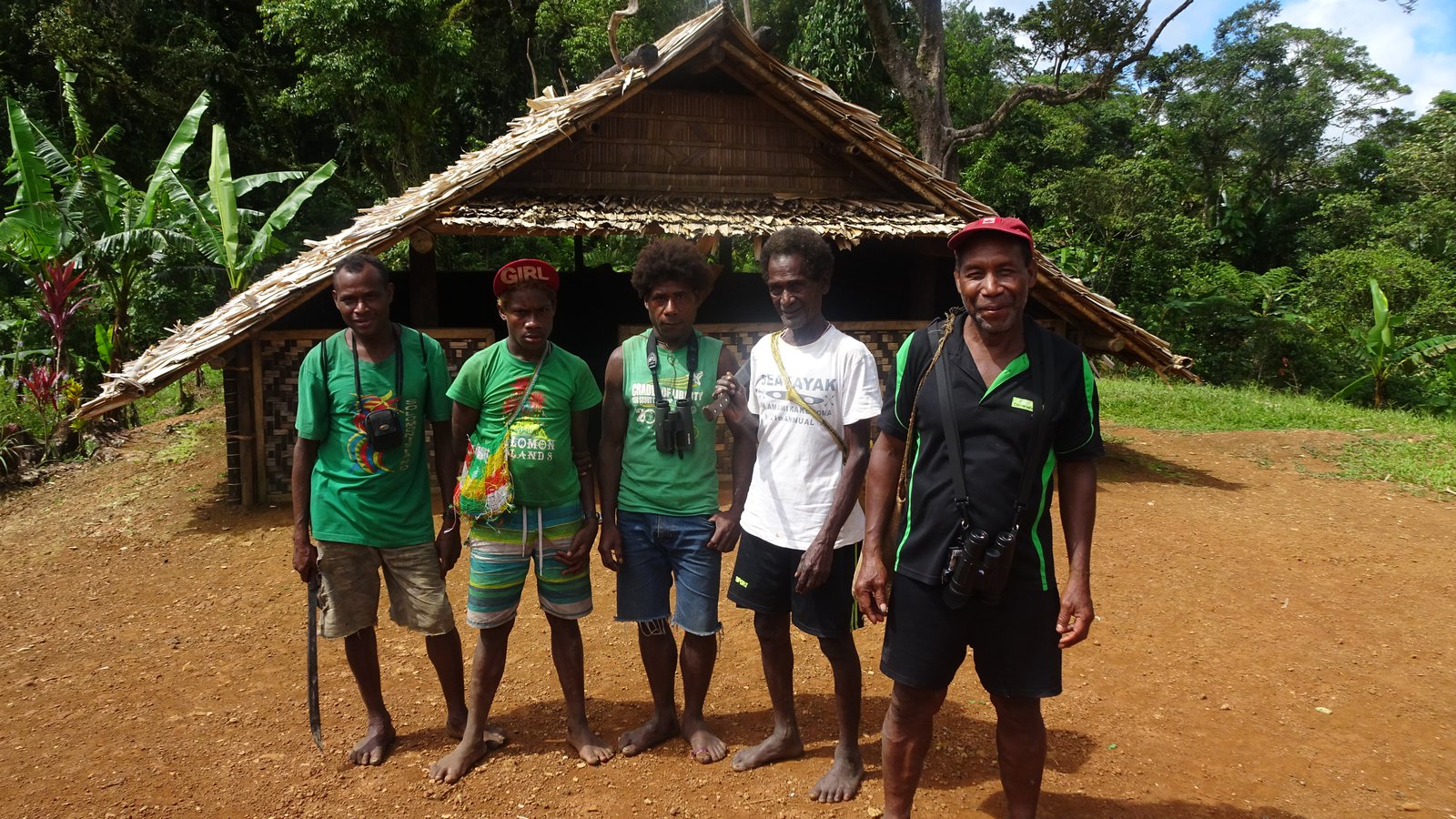Expedition to the Mountains of Malaita
From 22nd October until 2nd November, 2018, “Bouncer” and “Bone Nothing”[1] from the Australian Museum worked with a large and enthusiastic team from the Kwainaa`isi Cultural Centre to undertake a comprehensive bird survey from the coast to the highlands of Malaita. The goal was to formalize the knowledge base of the species protected in three conservation reserves established as a grassroots vision of local tribes on their Kastom land to protect their environment and culture from threatening processes, including the logging that is rampant in the Solomon Islands. The Kwainaa`isi Team was led by Chief Esau Kekeubata, and the trip was facilitated by David MacLaren from James Cook University, who has spent 20+ years working on public health in the Solomons. This account describes the overall journey, and links to other blogs which detail the langassi (“birds” of Kwaio).
[1] Non-judgmental and affectionate Pijin words relating to self-evident body shapes. Loosely translated to “Fatty and Skinny”.
Despite some rain on the day of our departure from Sydney, the grass airstrip at Atoifi was open and after a few fish-tails, our plane arrived at the terminal, and we were transferred to our first base camp on the island of Gala, which is separated from the mainland by extensive mangrove forests and channels. After a warm welcome from our hosts, Rex and Lucy, we quickly set about surveying the island and attempted to catch some birds over the next three days with only limited success – a single Susufunale (Olive-backed Sunbird) and one La`e (Willie Wagtail).
We enjoyed our first binu-binu – traditional dance accompanied by `aau (pan-pipes), gigilo (tuned percussion) as well as some serious hand/leg clapping – and got to model our new field attire. We also took a day trip down the coast to `Oloburi to visit the newly established `Aa`aesina Cultural Centre, and took the opportunity to look for some shorebirds. The laminated bird pictures we brought with us were of great interest to the local children, who gave us our first lesson in bird names in Kwaio language.
Once acclimatized to the tropics, we set off on 26th October to tackle the highland trek, which we now viewed with some trepidation. We had read Tim Flannery’s epic account of the trail in foul weather, and disconcertingly, everyone expressed amazement that Bouncer was going to attempt it. Although only a bit over 10 km, the track climbs steeply to over 900 m and involves mud-sliding, river-walking, rock-hopping and log bridges – every surface is teflon-coated. Fortunately, we had just had two days of sunshine after a day of rain, so had relatively good conditions, and although we found the heat hard going, we made it to Kwainaa`isi before nightfall. Bouncer was indebted to Chief Waneagea who was his personal trainer for the whole walk – “easy-easy: 200 steps and then a rest”. However, we were totally dependent on our willing and able carriers who skipped up the mountain with our 120 kg of equipment, including a drum of ethanol, leaving us to lug our water bottles (which our porters filled at every safe spring)! Before entering the village, we changed into traditional attire, and were given a warm Kwaio welcome, before settling into our accommodation.
The following day was spent in meetings with all the local chiefs and mountain tribes to discuss the work plan and identify any no-go areas and species of special significance. A consensus was reached that we should not collect the Faada (Solomons Sea-Eagle), or the Didioko (Malaita White-eye), but it would be okay to photograph them, measure them and take a blood sample should we encounter them in our mist nets.
The song of the Didioko is an important signal from the ancestors for providing guidance on the solution to troublesome problems. If there is some misfortune, the Chief and/or Priest will evaluate the different courses of action, and after deciding on the best way forward will prepare a pig for a sacrifice. If the Didioko calls, it is a sign of verification and the sacrifice should proceed. But if the Didioko is silent the hypothesis is falsified and the Chief must reconsider the alternatives. (Clearly, we did not want the blood of any Didiokos on our hands).
Our meetings resulted in an explicit and consensual work plan. We would work as two teams – one survey team (Team Bouncer), and one collection team (Team Bone Nothing), each of around 10 people. After a few days surveying the Kwainaa`isi Conservation Reserve, we would then shift camp to the Kafurum Reserve. It was decided, after viewing Bouncer and Bone Nothing climb the mountain that it would involve too much travel time to survey the third reserve, `Aifasu, on this expedition.
At the conclusion of the meetings, the Australian Museum representatives presented the Kwainaa`isi Culture Centre with two pairs of binoculars and a laminated field guide which proved invaluable over the coming days. The day finished with a welcoming feast of roast pig, taro, sweet potato, rice, water cress, followed by some joyous binu-binu to celebrate the beginning of our collaboration and to farewell David, who walked back to the coast the following morning to continue work on his health projects there .
For the next two days we started at 5.30 am and finished up at 9 pm conducting repeat surveys, checking our mistnets throughout the day and processing specimens into the evening. The Kwaio Rangers were already well trained in the use of mistnets from their work on Monkey-faced Bats, and so we were able to run 10 nets simultaneously, with plenty of people available to monitor them. After good success in catching birds that made use of the lower canopy, we abandoned our aluminium mistnet poles and the Kwaio people demonstrated their tree-climbing skills to set the nets in the canopy, bringing additional species within reach. They also made some opportunistic collections using bow and arrow, throwing stick and hand-collection of birds roosting at night in trees and caves.
Up to this point we had identified three of the four bird species endemic to Malaita, but Bouncer had had only one glimpse of the elusive La`e ni ile (Malaita Fantail), and wanted corroborative evidence. A spontaneous meeting of the Kwaio staff then developed a modified work plan. They wanted to search for La`e ni ile in some more distant sites where the Kwainaa`isi Rangers had seen it when doing their homework in preparation for the expedition. Not only would this search entail considerable travel time if slowed down by Bouncer and Bone Nothing, but it involved traversing some land owned by tribes who had not been involved in approval of the work plan. We decided that the safest and most time-effective approach was to split into four teams, with two swat teams to search for La`e ni ile and one bird team to continue work at base camp Kwainaa`isi along with the logistic support team. Team Waneagea and Team Maasafi set out immediately, while Team Esau and Team Dorothy remained with Bouncer and Bone Nothing. The Didiokos called enthusiastically!
With growing survey effort, and occasional runners from the swat teams bringing back new species, our checklist grew impressively and eventually, with the exception of La`e ni ile, we had tangible records of all the perching birds known from Malaita (unless you include the Tree Martin for which records are a bit sketchy). Clearly the Kwainaa`isi Conservation Area is well-chosen to fulfill its vision! A runner also brought news that Team Waneagea had seen La`e ni ile, but that it had disappeared quickly. Then on 28th October, after closing our nets at the end of the day, a runner brought back a “special” bird. Sure enough, Team Waneagea had captured the Malaita Fantail!
Faao (Fruit pigeons) were added to our specimen list in the final days and throughout our eight days at Kwainaa`isi we also collected blood samples, measurements and photographs of multiple individuals of species which were released alive – including six Didioko.
Our final day at Kwainaa`isi was the weekly cultural day when all the local tribes come together to learn, practice, teach and produce important cultural artefacts including shell money, baskets, mats, pipes, percussion sticks, carvings, combs and medicine. For the whole day everyone within the village must wear traditional dress while going about their activities. When not partaking in the cultural activities, Bouncer and Bone Nothing, processed some final specimens and packed up the equipment for the final walk home. Esau negotiated a last-minute pig purchase on our behalf, so as the evening approached we had a final feast with much binu-binu to celebrate an expedition that far exceeded our expectations both scientifically and culturally.
Gravity facilitated the trip back down the hill, so although Bouncer left early and conducted 21 spot surveys on the way down the mountain, he was still waiting at the swimming hole when the rest of the team arrived. Overall, the combined team recorded 73 bird species on the expedition, 41 from Kwainaa`isi and 33 from the lowlands, which were relatively depauperate, but supplemented by some shorebirds and seabirds. We collected 61 samples (specimens and blood samples) of 17 species, considerably increasing the Museum’s existing collection from Malaita which previously consisted of just four specimens of three species. Another exciting find was that in preparing for the expedition Maasafi had set a camera trap at an egg he discovered on the edge of a water course. He came back to find photographic evidence of what Bouncer identified as a Solomons Nightjar – the first record of this species from Malaita!
Finally, this was the first visit by a group of Ala`ikwao (white people) since the reconciliation between Australians and Kwaio that was held in July 2018. This reconciliation followed 90 years of tension following a massacre of Kwaio people in 1927 carried out by the Australian armed forces and local police. Until this reconciliation, involving extensive negotiations by Chief Esau, tensions have remained, and the highlands of Malaita have been a dangerous place for white people. Consequently, there has been negligible fauna survey for nearly 100 years. However, the local knowledge of the fauna is phenomenal and after extensive consultation with several tribes we were able to compile a checklist of the Kwaio names for all the bird species known to occur in Kwainaa`isi. The scene is set for well-informed conservation management of Malaita’s birds, and equally productive expeditions to survey other fauna groups in the future.
Bouncer and Bone Nothing are indebted to the hospitality, patience, knowledge and teaching provided by the Kwaio people. We enjoyed sharing ngali nuts, hairy caterpillars, stick insects and fruit bats. Bouncer also enjoyed the soccer, card-playing, watersports, and of course the binu-binu. It was a magical, memorable and productive expedition!
Richard Major (Principal Research Scientist, AMRI, Australian Museum), and
Corey T. Callaghan (PhD Candidate, Centre for Ecosystem Science, UNSW Sydney; and Research Assistant, AMRI, Australian Museum)
With:
Esau Kekeubata (Kwainaa`isi Cultural Centre)
Tommy Esau (Kwainaa`isi Cultural Centre), and
David MacLaren, James Cook University
More information:
1) Flannery, T. (2018). Basiana’s Pig. A story of murder and redemption from the Solomon Islands.








































































